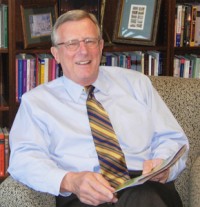Lincoln log: Reading recommendations
This year marks the 200th anniversary of the birth of Abraham Lincoln, which makes this summer a good time to read or reread a Lincoln biography. The more I learn about Lincoln the more fascinated I am by his range of intellectual curiosity, by his voracious reading, by his management skills, by his tolerance of ambiguity—and by his religious sensibilities, which are finally receiving the scholarly attention they deserve.
David Herbert Donald’s 1995 portrait Lincoln limns not only the personal and political character of the 16th president, but also the contours of Lincoln’s social world. Donald reveals Lincoln’s personal views on race (which, early in his life, were no more advanced than the average American’s—but which did evolve) and on slavery (to which he was unalterably opposed from early on). As for religion, Donald mentions Phineas Densmore Gurley, pastor of the New York Avenue Presbyterian Church in Washington, which the Lincolns attended, but doesn’t say much about him or his relationship with Lincoln.
Doris Kearns Goodwin won the Pulitzer Prize for Team of Rivals (2005). She recounts the hard-fought contest for the Republican presidential nomination in 1860, and how William Seward, Salmon Chase and Edward Bates were dismayed when a modest lawyer and former one-term member of Congress from Springfield, Illinois, emerged as the winner. As Kearns’s title indicates, Lincoln did the unthinkable as president: he appointed his rivals to his cabinet and patiently, over time, enabled them to become the team that preserved the union. At 944 pages, Kearns’s book is more suited for porch reading than airplane reading (the same could be said for Donald’s 720-page tome).
So is the newest work about the Great Emancipator, A. Lincoln: A Biography, by Ronald C. White Jr. (816 pages). Civil War historian James M. McPherson says that White’s book is the best biography of Lincoln since Donald’s and that in some ways it is better because it incorporates recent scholarship and pays more attention to Lincoln’s religious thinking.
Lincoln, we learn, spent a lot of time listening to sermons—by Gurley and by James Smith at the First Presbyterian Church in Springfield. Both pastors were with Lincoln at the most painful moments of his life: the deaths of his sons. Both were “Old School” Presbyterians who preferred a rational form of Calvinism to “New School” evangelical enthusiasm. Lincoln liked their literate and logical preaching, and he kept a copy of Smith’s book, The Christian’s Defence, on his shelf.
White suggests that Lincoln’s approach to religion was shaped by his distaste for his father’s emotional faith. Lincoln never joined a church, was uncomfortable with orthodox dogma, read Tom Paine’s critiques of religion with great interest and seems to have lived with a high degree of theological uncertainty. Yet his speeches contain many biblical allusions, and he had memorized passages of scripture, including the Sermon on the Mount and many Psalms. White eloquently portrays Lincoln’s struggles with discerning the will of God during the Civil War. Lincoln seems to have adopted Smith’s and Gurley’s view of God’s providence at work in the world. Lincoln’s spiritual struggles led theologian Elton Trueblood to call him “the theologian of American anguish.”
If you don’t have time for one of these three big books, I’d recommend James McPherson’s crisp, eloquent Abraham Lincoln. At 96 pages, it will fit easily in your briefcase.





